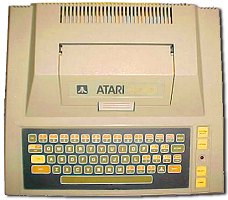 Atari’s popular computer line was never in the game plan of the company’s founding fathers.
Atari’s popular computer line was never in the game plan of the company’s founding fathers.
Neither was making the Atari VCS one of the longest-lived consoles in the history of video gaming. And neither was selling Atari to Warner Communications. But the latter is exactly what Nolan Bushnell was forced to do in 1977. Faced with diminshing cash flow and an uncertain consumer market that had washed its hands of the home video game “fad” once already, Bushnell had to either find a corporate buyer to keep Atari alive, or close the company’s doors forever. Warner swept in and bought the company, and the new Warner-appointed CEO Ray Kassar not only refused to pull the plug on the VCS (Bushnell had already given up hope on the console maintaining its profitability), but opened a new home computer division. The mandate was simple: Atari’s computers should be invaluable for home and business use…and they should play some great games.
The cultural clashes between Bushnell’s old guard and Kassar’s old school business acumen are legendary, and those power struggles eventually got Atari’s founder removed from the company’s board. In the meantime, Atari’s computer line launched successfully in 1979 as one of the very first low-priced competitors to the pricier Apple II home computers, and before Commodore’s series of consumer-priced post-PET computers. The 16K Atari 400, with its membrane keyboard, and the 48K Atari 800 led the pack, complete with cassette and floppy disk drives. As the video game market collapsed and gave way to the home computer market, Atari followed these models up with the Atari 1200, 600XL, 800XL and 1200XL.
That Kassar was gunning for Apple is ironic in hindsight. Prior to the Warner sale, Bushnell had employed a young computer enthusiast named Steve Jobs, and on one occasion, Jobs and his best friend Steve Wozniak had collaborated on the design and programming of an arcade game called Breakout. When Wozniak and Jobs created the Apple I as a hobby project in their spare time, they showed it first to Atari; Bushnell wasn’t interested in venturing into home computers at the time, but pointed them in the direction of venture capitalist Don Valentine (who later funded a game-making startup called Electronic Arts), who in turn introduced Jobs and Wozniak to Mike Markkula, who provided Apple’s startup capital. Due to Bushnell’s fixation on creating game consoles and not computers, Atari missed out on having its name on the top-selling personal computer of the early 80s.
It was during the mid-80s crash of the video game industry that Atari was once again sold, this time to former Commodore Computer CEO Jack Tramiel. Wanting to re-launch Atari as a home computer maker and use it to get revenge on Commodore (from which he had been forcibly ousted), Tramiel all but eliminated the home video game division, and Warner held on to the arcade division, later selling it to Midway. Amid sweeping personnel changes, Tramiel installed his sons in key positions in the company and chased off many of the remaining game designers who had helped Atari ascend to its pre-crash heyday. A new console, the Atari 7800, was shelved indefinitely despite being a major technological advance among game consoles. Tramiel’s reign saw the introduction of the popular ST series of computers, as well as a lame duck attempt to launch a hybrid game console/low-end personal computer, the Atari XE.
Though many unique plans were on the drawing board, including portable computers that predated Compaq’s first laptop, the Atari ST line couldn’t compete with the PC-compatible juggernaut which also eventually eliminated such competition as the Apple IIGS and Commodore’s Amiga. Atari gave up the ghost on the ST in the early 90s and instead tried to launch a series of PC-compatible desktop machines, but businesses just weren’t ready to do their accounting, inventory and bookkeeping on a machine bearing the same logo as countless video game machines, and it is there that Atari’s computer legacy comes to a quiet, unremarkable end.
In 1996, Tramiel quietly merged Atari with a hard drive manufacturer, JTS, primarily to gain a seat on the latter company’s board. JTS later sold the Atari name and intellectual properties to Hasbro Interactive for a paltry $5 million, and Hasbro returned Atari to some semblance of its former glory by releasing retro-oriented titles like Missile Command and Pong for modern PCs and game systems. Hasbro Interactive eventually ran aground, and the Atari name and properties once again changed hands, this time being bought by French game publisher Infogrames.
[jwcatpostlist orderby=title order=asc includecats=36]